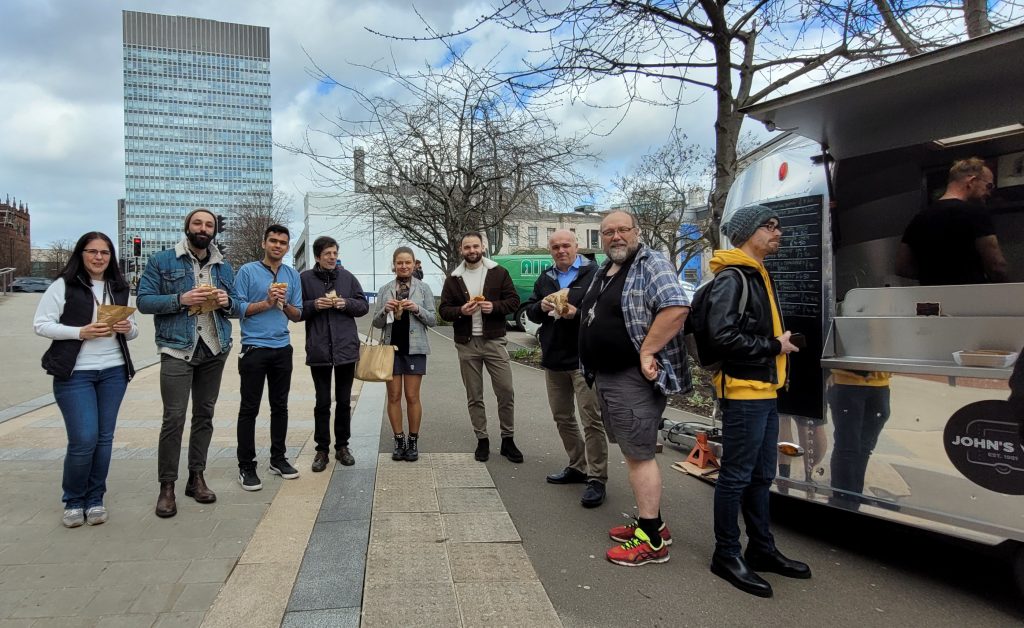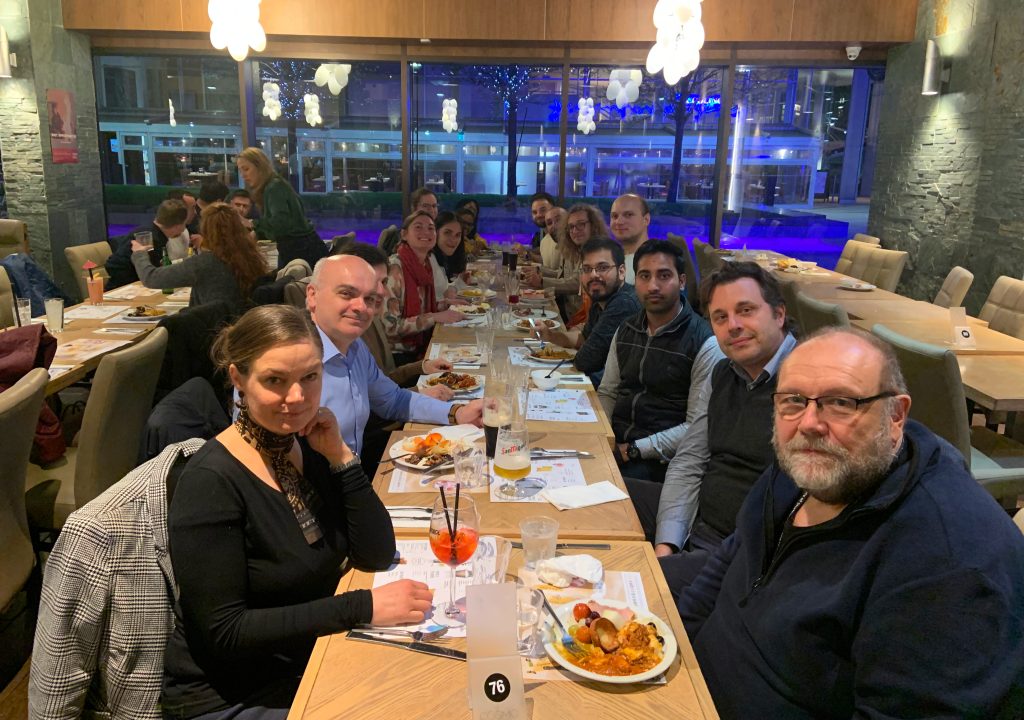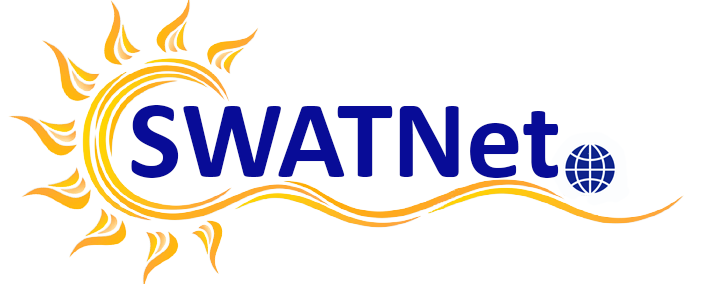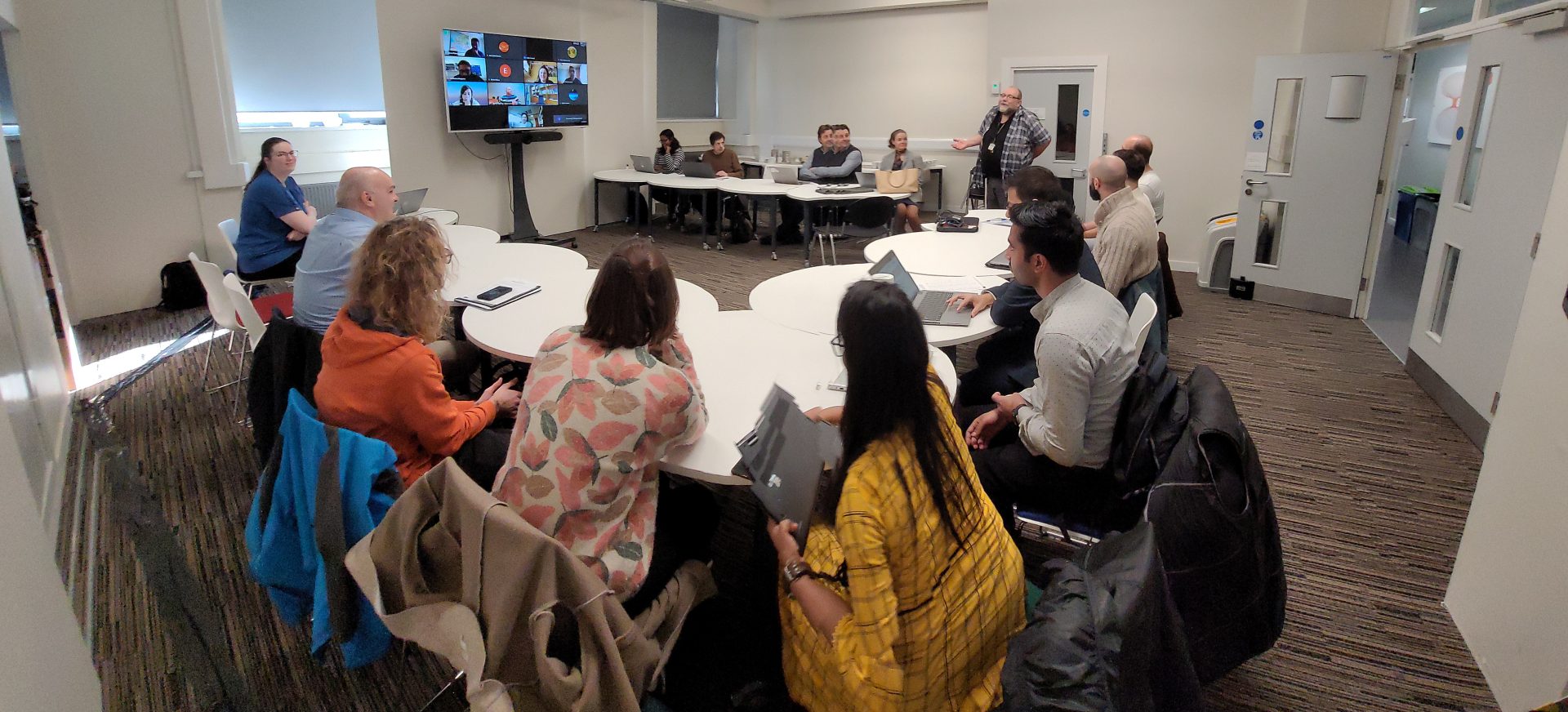
Second year of SWATNet
text: Emilia Kilpua; pictures: Marianna Korsos & Emilia Kilpua
The Annual Meeting 2 was organized at the University of Sheffield 22 March 2023. 16 attendees participated in person and 20 joined online
The meeting started with participants introducing themselves, followed by students’ presentations and a discussion with our external advisory board. After the lunch we discussed training activities in SWATNet with the focus on the upcoming industrial training. The Annual meeting concluded with summaries from outreach/dissemination activities and the project management.
Overview
The second year of SWATNet (March 2022 – February 2023) passed smoothly. All deliverables were submitted in time and we organised all planned activities (School 2, Workshops 2, 3 and 4). All of our ESRs have now started working on their projects. Highlights are
- SWATNet’s first face-to-face training events were organised.
- ESRs participated to many scientific conferences both onsite and online
- Observatory training at the Gyula Bay Zoltán Solar Observatory
- Research work is in full progress with many intriguing research results
Science
Students gave five-minute presentations on the status of their research work.
In Work Package 1 several new findings have been made towards identifying optimal predictors for solar flares and coronal mass ejections (CMEs). Augustin (project 1) has developed methods to assess the role of transient brightening in active regions that produce solar flares. Shifana (project 2) has calculated magnetic helicity for a CME that was observed by Solar Orbiter on 10 March 2022 both remotely and in-situ. Shreeyesh (project 3) assessed the success of several precursors for the occurrence of X-class flares from which the most promising was a parameter related to filtered unsigned magnetic flux. Guilherme (project 4) is working to improve a method targeted for forecasting the amplitude of solar cycle.
The Work Package 2 has made significant progress in developing models for space weather forecasting. Mayank (project 5) has investigated the heating of the corona using two-fluid simulations. Andreas (project 6) has developed automated methods for identifying and tracking flux ropes in data-driven lower coronal simulations. Lidiya (project 7) has shown that taking into consideration focusing due to an inhomogeneous magnetic field is important for particle acceleration in the corona. Edin (project 8) has coupled an energetic particle code into two heliospheric models (EUHFORIA and Icarus) to investigate how charged particles are energized and transported in interplanetary space. Ronish (project 9) has investigated the propagation of over 200 CMEs using a semi-empirical model where CME dynamics are dominated by magnetohydrodynamic solar wind drag.
In Work Package 3 several intriguing results have been made that are expected to have a significant impact on machine learning based space weather forecasting. They also help to address the ‘black box’ problem that refers to lack of physical explainability. Gregoire (project 10) combined magnetograms and solar atmospheric images in deep-learning forecasting taking into consideration features such as bright points, coronal loops, sigmoids and small magnetic elements. Simone (project 11) trains and tests a machine learning algorithms to predict whether a CME will hit the Earth. Slava (project 12) has used mathematical morphology method to identify delta-sunspots that are magnetically complex regions leading to the strongest eruptions and space weather storms.
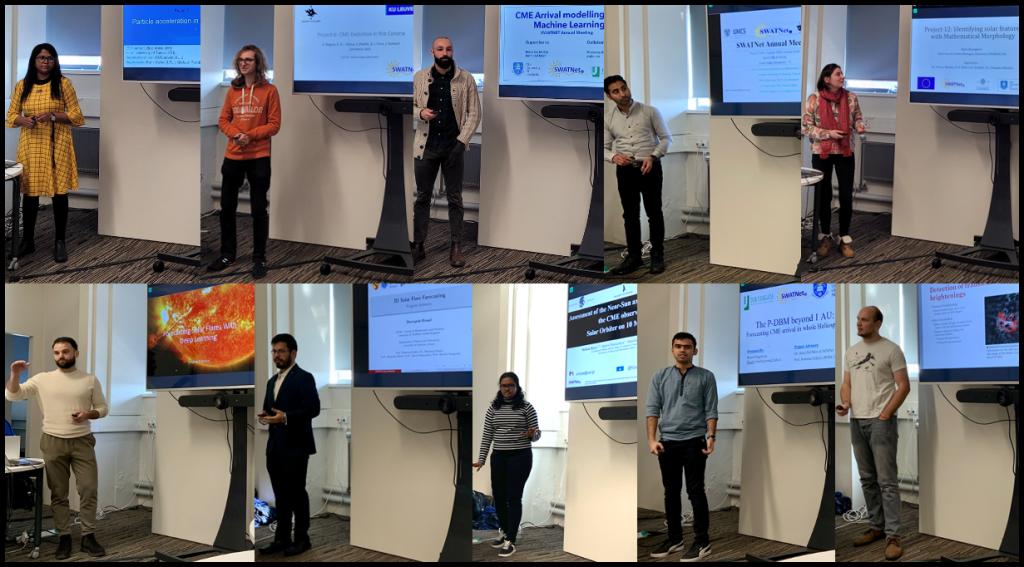
External Advisory Board
Our External Advisory Board (EAB) members gave detailed feedback for students on their scientific work and valuable suggestions regarding general aspects of the network.
All considered that SWATNet is on a good track. They were happy to witness that students have made significant progress in their research, presented with confidence and were able to answer the questions without intervention from their supervisors.
The EAB suggested paying attention to the number of publications both for academic competitiveness and meeting the PhD requirements. This raised discussion. The scientific research is compromised by an ambitious training schedule and mobility required in the network. On the other hand, students build a curriculum that is attractive both for academia and industry. In addition, during their first year students have adapted to new environments and taken courses at their host universities. After the first paper, the next ones come usually smoother, but we all agreed that it is important to pay attention to this.
The EAB also reminded that Marie Curie networks are excellent environments to foster scientific collaborations between the students. Several of our students already work together, but since it is more productive and nicer to work together than alone we will think of additional synergetic research activities. One option we discussed is that ESRs organise regular gatherings themselves.
The importance of discussing students’ expectations after the thesis is completed was raised. This is part of the career development plans and we remind all to discuss this when the plans are updated. The last workshop of SWATNet is also dedicated to career prospects. Our students will be given broad training that allows them to choose the path they want to take after finishing their PhD.
Training activities
During the second year we organized three workshops and one school. Workshop 2 on managing a Research project was held online after Annual Meeting 1.
Next activities were in person. First we met at the University of Coimbra in June to learn about outreach and communication in Workshop 4. In September a School 2 on Sun-Earth interactions and Workshop 3 on solar activity and space weather were held back-to-back in Athens.
Eight of our ESRs completed their 1-month training at the Guyla observatory. Despite some minor problems with electricity etc the experience was very positive and many students would be happy to return to the observatory. One month seemed too short to get to fully know the pipeline to make observations.
During the second year, six ESRs started their secondments at the other SWATNet host. For example, Mayank relocated from Lublin to Helsinki and Andreas from Helsinki moved to Leuven. This mobility is one of the great assets of doing Cotutelles. Students get immersed in different environments and supervising practices.
All our industrial partners were presented at the meeting. We heard several exciting initial ideas planned for the training, including instrumental activities related to radiation measurements onboard high-altitude balloons, contributing to the development of X-ray and in-house space particle instruments and CubeSats, and participating in start-up activities.
It was reminded by IPN’s Pedro Lacerda that the number of satellite launches is rocketing up. The satellites are vulnerable to space weather and experts are urgently needed to the field and related companies.
One important practical aspect that came up was that it is strongly recommended (or even obligatory) to have a signed agreement between the company and host university/institute to agree on insurance, personal data treatment, confidentiality clause, ethical aspects etc. Another useful document is a study plan to cover the training schedule, content and objectives.
Outreach activities
Scientific results have been presented to a wider scientific community in several national and international meetings, both in-person and online.
The image and movie gallery was opened. It presents a selection of visually impressive research outcomes with brief explanations.
One of the highlights of the second year was that SWATNet participated in the STEM Discovery Campaign. The project activities were presented in social media to nearly 200k participants. We also recently joined the Horizon Results Booster service that aims at disseminating project results widening its impact and identifying stakeholders by grouping with similar types of projects.
In 2022 we selected ResearchGate and LinkedIn to add to our social media repertoire. While ResearchGate is used widely in research, LinkedIn is foreseen to be useful in particular to those students who decide to continue to industry. The students will also be trained to do their own personal LinkedIn pages.
The project activities were summarized in our second Newsletter published in February 2022.
It was great to meet in Sheffield and we are looking all forward the third year of the project!
